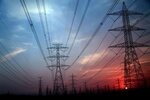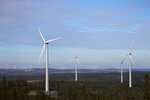News Release from Repsol
Wind Industry Profile of
Repsol and Ibereólica Renovables complete construction of Cabo Leones III, their first joint wind farm in Chile
Repsol and the Ibereólica Renovables Group have completed construction of Cabo Leones III, the companies’ first joint wind farm in Chile. The wind farm, with a total installed capacity of 188.1 MW, is located in the province of Huasco in the northern region of Atacama.
The wind farm's first phase launched at the end of 2020, with 78.1 MW generated by 22 Siemens-Gamesa wind turbines (SG-132) with nominal power of 3.55 MW. An additional 22 Siemens-Gamesa wind turbines (SG-145), with nominal power of 5 MW, were installed in this second phase to add 110 MW of installed capacity.
As the second phase approaches completion, commercial operations are slated to begin in the fourth quarter of 2021. Together, both phases are expected to produce approximately 520 GWh of power per year with the capability of meeting the energy needs of 170,000 Chilean households.
Cabo Leones III has also made a significant contribution to local job creation, including up to 150 workers on the ground. Also, the clean, renewable power generated by the wind farm will save approximately 418,000 tons of CO2 in annual emissions for the region.
Repsol and the Ibereólica Renovables Group secured long-term funding for Cabo Leones III through a project financing arrangement worth $209 million with Spanish and international financial institutions. The deal includes long-term debt and establishes a series of guarantees.
As part of the joint venture in Chile between Repsol and the Ibereólica Renovables Group, the Cabo Leones III wind farm belongs to a portfolio of assets already in operation, under construction, and in advanced stages of development totaling more than 1,600 MW and slated for commercial use through 2023, with the possibility of surpassing 2,600 MW by 2030.
In addition to Cabo Leones III, in the period until 2023, the joint venture also foresees carrying out the Atacama wind farm project with a total installed capacity of up to 180 MW.
In late July, Repsol raised its low-emissions power generation capacity target to 8.3 GW, up from the original commitment of 7.5 GW set in its 2021–2025 Strategic Plan. This increase of over 10% in its low-emissions power generation target, which is one of the pillars of the company's decarbonization model, is based on the expected growth of renewables.
Outside Chile, Repsol already boasts one fully operational wind farm in Spain — Delta, with 335 MW — in addition to five other renewable projects across the Iberian Peninsula in various phases of development: two wind farms (Delta 2 with 860 MW, already under construction, and PI with 175 MW) and three photovoltaic solar farms (Kappa with 126 MW and Valdesolar with 264 MW, both already partially operational, and Sigma with 204 MW). Repsol is also part of the consortium behind one of the world's largest semi-submersible wind farms, WindFloat Atlantic, which is operating off the Portuguese coast. On top of these assets, Repsol has gained a foothold in the United States renewables market though its acquisition of 40% of Hecate Energy, specialists in solar photovoltaic and battery storage project development. Headquartered in Chicago, Hecate Energy has a portfolio of more than 40 GW of renewable and energy storage projects under development.
The Ibereólica Renovables Group has more than 24 years of experience in renewable power generation projects. Its 12 operating wind farms have total installed capacity of 205 MW in Spain and 613 MW in Chile, with another 450 MW currently under construction in Chile. It can also claim a 10 GW platform of wind, solar photovoltaic, and hydraulic projects in various stages of development in Spain, Chile, Peru, and Brazil.
- Source:
- Repsol
- Author:
- Press Office
- Link:
- www.repsol.com/...
- Keywords:
- Repsol, Ibereólica Renovables, construction, Cabo Leones III, wind farm, Chile, onshore, MW, capacity, Atacama, Siemens Gamesa, turbine


























